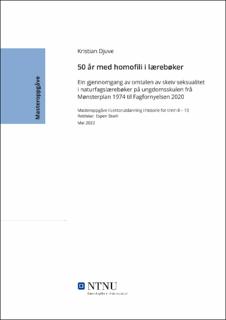| dc.contributor.advisor | Storli, Espen | |
| dc.contributor.author | Djuve, Kristian | |
| dc.date.accessioned | 2022-09-20T17:20:26Z | |
| dc.date.available | 2022-09-20T17:20:26Z | |
| dc.date.issued | 2022 | |
| dc.identifier | no.ntnu:inspera:109398136:22975819 | |
| dc.identifier.uri | https://hdl.handle.net/11250/3019890 | |
| dc.description.abstract | 50 år er gått sidan homofili vart lovleg i Noreg. Sidan den tida har homofiles rettigheter og status i samfunnet auka. Til tross for dette finnes det framleis negative haldningar til skeiv seksualitet rundt omkring i landet. Skulen er ein stad haldningane til folk kan påvirkes anten gjennom undervisning frå lærar eller gjennom innhaldet i lærebøkene. Tidlegare forskning viser lærebøker er prega av eit heteronormativt syn på seksualitet og forhold. Dette kan vera ein faktor som bidrar til negative haldningar til skeiv seksualitet.
Det denne oppgåva har hatt som formål er å kartlegge utviklinga i omtalen av skeiv seksualitet i naturfagsbøker på ungdomsskulen sidan homofili vart lovleg i 1972, samt sjå på om heteronormativitet har prega framstillinga av seksualitet. 26 naturfagsbøker fordelt på dei fem læreplanane som har vore aktive i perioden, samt to naturfagsbøker frå før homofili vart lovleg er inkludert i studien.
Oppgåva viser at omtalen av skeiv seksualitet har auka i kvar læreplanperiode og er vesentleg større i dei nyaste lærebøkene enn i bøkene frå 1970-talet. Den verkelege auka kom dog ikkje før i forbindelse med læreplanen Reform 1997 – den første læreplanen som nevner seksuell kjønnsidentitet og homofili på lik linje med heterofili. Oppgåva viser dog at mykje av den auka omtalen tar for seg historiske og samfunnsfaglege aspekt og ikkje naturfaglege aspekt. Omtalen av skeiv seksualitet står også i stor grad skilt ut frå anna omtale av seksualitet i så vel dei gamle som dei nye bøkene, noko som skapar ein følelse av at dette er annerledes av normalen. Dei delane av naturfagsbøkene som tar for seg seksualitet fokuserer i stor grad på at dette er noko som omhandlar mann og kvinne og ikkje andre kjønnskonstellasjonar – også dette gjeld dei gamle så vel som dei nyare bøkene, sjølv om dei nye bøkene har meir generelle omtalar som også kan tolkast i retning av mann/mann- og kvinne/kvinne-forhold.
Sjølv om omtalen av skeiv seksualitet i naturfagsbøker på ungdomsskulen har auka sidan 1972, og omtalen av seksualitet har blitt meir nøytral, er det framleis eit godt stykke å gå før homofili kan sidestilles med heterofili i skulebøkene med tanke på å framstille det som normalt. | |
| dc.description.abstract | 50 years have gone since homosexuality became legal in Norway. Since then gay rights and their status in society has increased. Despite this there are still some negative attitudes to queer sexuality around the country. The school is a place where peoples attitude can be affected, either through teaching from the teacher or through the content of the school books. Previous research shows that school books are characterized by a heteronormative view on sexuality and relations. This can be a factor that contributes to negative attitudes toward queer sexuality.
The purpose of this thesis has been to map the development in the mention of queer sexuality in science textbooks in upper secondary school since homosexuality went legal in 1972, and to look at whether heteronormativity has characterized the presentation of sexuality. 26 science textbooks from the five curricula that have been active during the period, as well as two science textbooks from before homosexuality went legal are included in the study.
The thesis shows that the mention of queer sexuality has increased in each curriculum period and is significantly greater in the newest textbooks than in the books from the 1970s. However, the real increase did not occur until the Reform 1997 curriculum - the first curriculum that mentions sexual gender identity and homosexuality in the same phrase as heterosexuality. However, the thesis shows that much of the increased coverage deals with historical and social science aspects and not natural science aspects. The mention of queer sexuality is also largely separated from other mentions of sexuality in both the old and the new books, something that creates a feeling that this is different from the normal. The parts of the science books that deal with sexuality focus to a large extent on the fact that this is something that deals with men and women and not other gender constellations - this also applies to the old as well as the newer books, although the new books have more general references such as can also be interpreted in the direction of man/man and woman/woman relationships.
Although the mention of queer sexuality in science textbooks in upper secondary school has increased since 1972, and the mention of sexuality has become more neutral, there is still a long way to go before homosexuality can be equated with heterosexuality in school books in order to present it as normal. | |
| dc.language | nno | |
| dc.publisher | NTNU | |
| dc.title | 50 år med homofili i lærebøker | |
| dc.type | Master thesis | |
